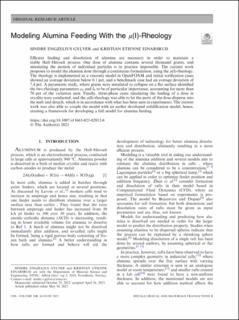Modeling Alumina Feeding With the µ(I)-Rheology
Journal article, Peer reviewed
Published version
Permanent lenke
https://hdl.handle.net/11250/3114527Utgivelsesdato
2023Metadata
Vis full innførselSamlinger
- Institutt for materialteknologi [2545]
- Publikasjoner fra CRIStin - NTNU [38070]
Sammendrag
Efficient feeding and dissolution of alumina are necessary in order to maintain a stable Hall–Héroult process. One dose of alumina contains several thousand grains, and simulating the motion of individual particles is in practice impossible. The current work proposes to model the alumina dose through a continuous formulation, using the µ(I)-rheology. The rheology is implemented as a viscosity model in OpenFOAM and initial verification cases showed an average deviation below 0.1 pct, and a benchmark case had an average deviation of 7.4 pct. A parametric study, where grains were simulated to collapse on a flat surface identified the two rheology parameters and to be of particular importance, accounting for more than 70 pct of the variation seen. Finally, three-phase cases simulating the feeding of a dose in cryolite were conducted, and the µ(I)-rheology was able to let the parts of the dose disperse into the melt and detach, which is in accordance with what has been seen in experiments. The current work was also able to couple the model with an earlier developed solidification model, hence, creating a framework for developing a full model for alumina feeding.

